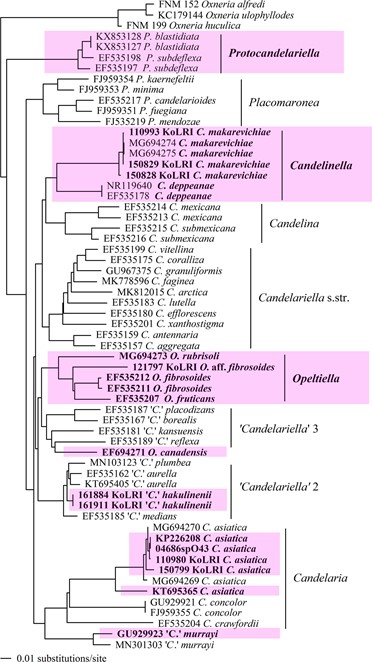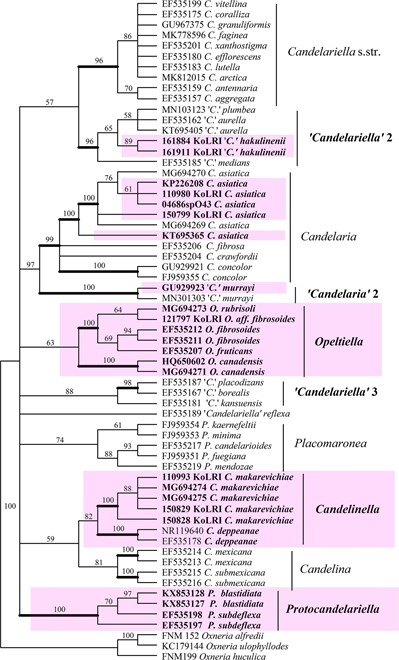Candelinella S. Y. Kondr., gen. nov.
MycoBank number: MB 836762; Index Fungorum number: IF 836762; Facesoffungi number: FoF;
Similar to the genus Candelina, but differs in having from indistinct areole to squamulose thallus, not being firmly attached to the substrate, and in having simple to 1-septate, narrowly ellipsoid to oblong ascospores, as well as in the lack of lower cortex and medulla, and in the lack of distinctly lobed thallus in the peripheral portion.
Type species: Candelinella makarevichiae (S. Y. Kondr., L. Lőkös et J.-S.Hur) S. Y. Kondr.
Thallus small, crustose, granular to areolate or squamulose; areoles convex, rounded to angular or irregular in outline, scattered to crowded, some- times aggregated into thicker crusts, green yellow to orange yellow, smooth. Apothecia lecanorine, darker yellow than the thallus, round, soon becoming strongly convex, where thalline margin seems to be excluded / disappearing, while it is well developed in section; paraphyses simple, cylindrical or with slightly swollen tips; hypothecium hyaline, asci 8-spored, ascospores hyaline, simple to 1-septate, narrowly ellipsoid to oblong; conidia hyaline, oblong to ellipsoid.
Chemistry: calicin, pulvinic acid, pulvinic dilactone, and vulpinic acid.
Etymology: The genus Candelinella is named after similarity to the genus Candelina based on combined multigene phylogeny and nrITS phylogeny.
Distribution and ecology: The genus hitherto includes two species, i.e. Candelinella makarevichiae from East Asia and C. deppeanae distributed in south- western North America. The latter species (i.e. C. deppeanae) might belong to another genus as the level of support of the Candelinella subclade is rather low. They grow on bark or on decorticated trunks of both coniferous (Juniperus deppeana and Pinus spp.) and deciduous trees (oak, cherry trees, etc.) and shrubs, from desert scrub, riparian woodland, canyons to pine forests up to 2,100 m a.s.l.
Taxonomic notes: The genus Candelinella is positioned in sister position to the genus Candelina based on combined multigene phylogeny (Fig. 2) and based on nrITS phylogeny (Fig. 1). The genus Candelinella is similar to the genus Candelina, but differs in having indistinct areolate to squamulose thallus, not being firmly attached to the substrate, and in having simple to 1-septate, narrowly ellipsoid to oblong ascospores (vs. simple and often slightly curved (bean-like)), as well as in the lack of lower cortex and medulla (vs. lower cortex and white or yellow medullar well developed), and in the lack of distinctly lobed thallus in the peripheral portion.
When Candelinella makarevichiae was described it was recorded from the bark of deciduous as well as coniferous trees. However, molecular data were obtained for this species only from material from the bark of coniferous trees. The question whether the material from the bark of deciduous trees is conspecific with the material from the bark of coniferous trees was still open at that time (Kondratyuk et al. 2018). Liu et al. (2019) provided data on specimens of this species on the bark of both coniferous and deciduous trees. Materials from both groups of phorophytes were found within this study to be the same.
Thus, it is for the first time shown that Candelariella subsquamulosa D. Liu et Hur, recently described from South Korea (Liu et al. 2019), is a new synonym of C. makarevichiae. The nrITS sequences of the holotype and isotype specimens of C. makarevichiae as well as of the holotype and paratype of C. subsquamulosa are the same (Table 1, Fig. 1). Based on nrITS phylogeny they are positioned in the same branch with the highest level of support. Thus, the conclusion that C. subsquamulosa is a new synonym of the Candelinella makarevichiae is drawn here.
table 1
Vouchers of the Candelariaceae for which newly generated molecular data as well as new names are identified
| Country, voucher specimen / reference | nrITS | 28S nrLSU | 12S mtSSU | |
| Candelaria asiatica | China, Cao et al. (2015 as Candelaria fibrosa) | KP226208 | ||
| Candelaria asiatica | Republic of Korea, 110980 KoLRI, this paper | 110980 | ||
| Candelaria asiatica | Republic of Korea, 150799 KoLRI, this paper | 150799 | ||
| Candelaria asiatica | Canada, Telfer et al. (2015 as Candelaria concolor) | KT695365 | ||
| Candelaria asiatica | China, Nan et al. unpubl. [2012], as Candelaria sp. O40 | JQ004686 | ||
| Candelaria asiatica | Republic of Korea, Liu et al. (2019) | MG694270 | MH101755 | |
| Candelaria asiatica | Republic of Korea, Liu et al. (2019) | MG694269 | MH101754 | |
| ‘Candelaria’ murrayi | Argentina, Westberg and Arup, as Candelaria fibrosa | GU929923 | ||
| ‘Candelariella’ hakulinenii | Republic of Korea, 161884 KoLRI, this paper | 161884 | ||
| ‘Candelariella’ hakulinenii | Republic of Korea, 161911 KoLRI, this paper | 161911 | ||
| Candelariella vitellina | Antarctica, Canini et al. [unpubl.], as Candelariella sp. | MK536666 | ||
| Candelinella deppeanae | USA, Westberg et al. (2007) | EF535178 | ||
| Candelinella deppeanae | Mexico, Westberg et al. (2007) | EF535179 | ||
| Candelinella makarevichiae | Republic of Korea, 110993 KoLRI, this paper | 110993 | ||
| Candelinella makarevichiae | Republic of Korea, 150828 KoLRI – holotype, this paper | 150828 | ||
| Candelinella makarevichiae | Republic of Korea, 150829 KoLRI – isotype, this paper | 150829 | ||
| Candelinella makarevichiae | Republic of Korea, 152676 KoLRI – Liu et al. | |||
| (2019 as Candelariella subsquamulosa) | MG694271 | MH101756 | ||
| Opeltiella aff. fibrosoides | Republic of Korea, 121797 KoLRI, this paper | 121797 | ||
| Opeltiella canadensis | China, Liu et al. (2019 as Candelariella canadensis) | MG694271 | MH101756 | |
| Opeltiella fibrosoides | Peru, Westberg et al. (2007 as Candelaria fibrosoides) | EF535211 | ||
| Opeltiella fibrosoides | Peru, Westberg et al. (2007 as Candelaria fibrosoides) | EF535212 | ||
| Opeltiella fruticans | Ecuador, Westberg et al. (2007 as Candelaria fruticans) | EF535207 | ||
| Opeltiella rubrisoli | China, Liu et al. (2019 as Candelariella rubrisoli) | MG694273 | MH101758 | |
| Protocandelariella blastidiata | Russia, Yakovchenko et al. (2017) | KX853127 | ||
| Protocandelariella blastidiata | Russia, Yakovchenko et al. (2017) | KX853128 | ||
| Protocandelariella blastidiata | Czech Republic, Yakovchenko et al. (2017) | MH145376 | MH156655 | |
| Protocandelariella subdeflexa | USA, Westberg et al. (2007) | EF535197 | ||
| Protocandelariella subdeflexa | USA, Westberg et al. (2007) | EF535198 |

Fig. 1. Position of Candelinella, Opeltiella and Protocandelariella species in the phylogenetic tree of the Candelariaceae based on nrITS phylogeny

Fig. 2. Position of Candelinella, Opeltiella and Protocandelariella species in the phylogenetic tree of the Candelariaceae based on combined multigene phylogeny
Species
